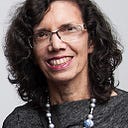The Girl Who Counted Numbers
A Novel that Took 61 years to write
61 years ago, I rolled a large metal trunk that held a heavy German portable typewriter up the gangplank of the SS Jerusalem of the Zim Lines on my way from New York City to Haifa, Israel. In those days, traveling to Israel by ship was much cheaper than flying there by plane.
I joined a group of 12 students from the Hiatt Program of Brandeis University who were on their way to Israel to study the politics and economics of the country. Some of us knew Hebrew (me) some of us barely knew the language. The courses were to be taught in English and we were all evaluated and sent to an Hebrew Language School (Ulpan) and placed in an appropriate level. I had started my schooling in a Brooklyn Yeshiva which taught Hebrew in the morning and English in the afternoon. By the time our family left Brooklyn, for the suburbs two years later, I could speak simple Hebrew. During the next few years, I learned more in an after-school program and in high school and college.
So, when I arrived in Israel, I found myself placed in the highest grade class 10 YUD, the only English speaking student in the class. Many of my classmates were from Morocco.
I had read considerable Jewish history but before this trip I had never met a survivor from the Holocaust in New York. In my schoolbooks, I saw shocking photos of starving survivors, piles of dead bodies, arms with numbers, shaved heads, prisoners digging ditches for their own graves, and trains stuffed with prisoners, their heads gasping for air. I saw photos of dilapidated Jewish ghettos, with two or three families sleeping in one apartment.
But it was not until 1961 when I arrived in Israel that I actually saw the survivors, many with numbers showing on their forearms because they were wearing short sleeved shirts in the hot Middle Eastern climate. They were everywhere and I got into the habit of counting them as I walked back and forth from my apartment in Rechavia to the Ulpan.
Each one: a distinct memory that found a place in my brain for six decades.
Classes at the Ulpan were quite different from the Hebrew that I had studied in America. Everything was in Hebrew and we used specially prepared newspapers with simple Hebrew. Most of the stories were to build up the image of the land of Israel, its agriculture, its manufacturing, its education, its patriotism. We were being educated to be loyal citizens, patriotic Zionists.
In the cafes along Ben Yehudah street people often talked about the Adolf Eichmann trial which had mesmerized the country for weeks. Since I understood Hebrew, I listened to the survivors tell their stories. One sad tale after another. One lucky person who had miraculously escaped. How some of them crossed the river and ended up in Russia –work camps instead of concentration camps.
I traveled up north by bus to visit my father’s first cousin who was a farmer in a Marxist kibbutz near Haifa. In the dining hall, a massive portrait of Karl Marx looked down on the modest tables and chairs. They were not religious but they were Zionists. They had fought off the mosquitos. They had built cement block houses with tin roofs. Most of the men were dressed in coveralls and straw hats. The only concession to Judaism, was lighting Shabbos candles on Friday night.
We met with Ben Gurion and with other Israeli officials to discuss Israeli politics, economics, health care, and education.
It was a seven month study program that remained in my mind until I won a writing fellowship to the Virginia Center for the Creative Arts in 2015. On the first day there, those 61 years poured out of me and I began to write my debut novel, The Girl Who Counted Numbers. It had taken me more than six decades to process what I had experienced as an American girl in Israel. It had taken me 61 years to transform what I had seen on the streets and in the cities into a novel. On the very first day, I skipped lunch and dinner and wrote the entire first chapter.
The Girl Who Counted Numbers, (A Novel) Amsterdam Publishers, New Jewish Fiction Series, October 12, 2022. Amazon and Ingram. Available for Pre-Order.
